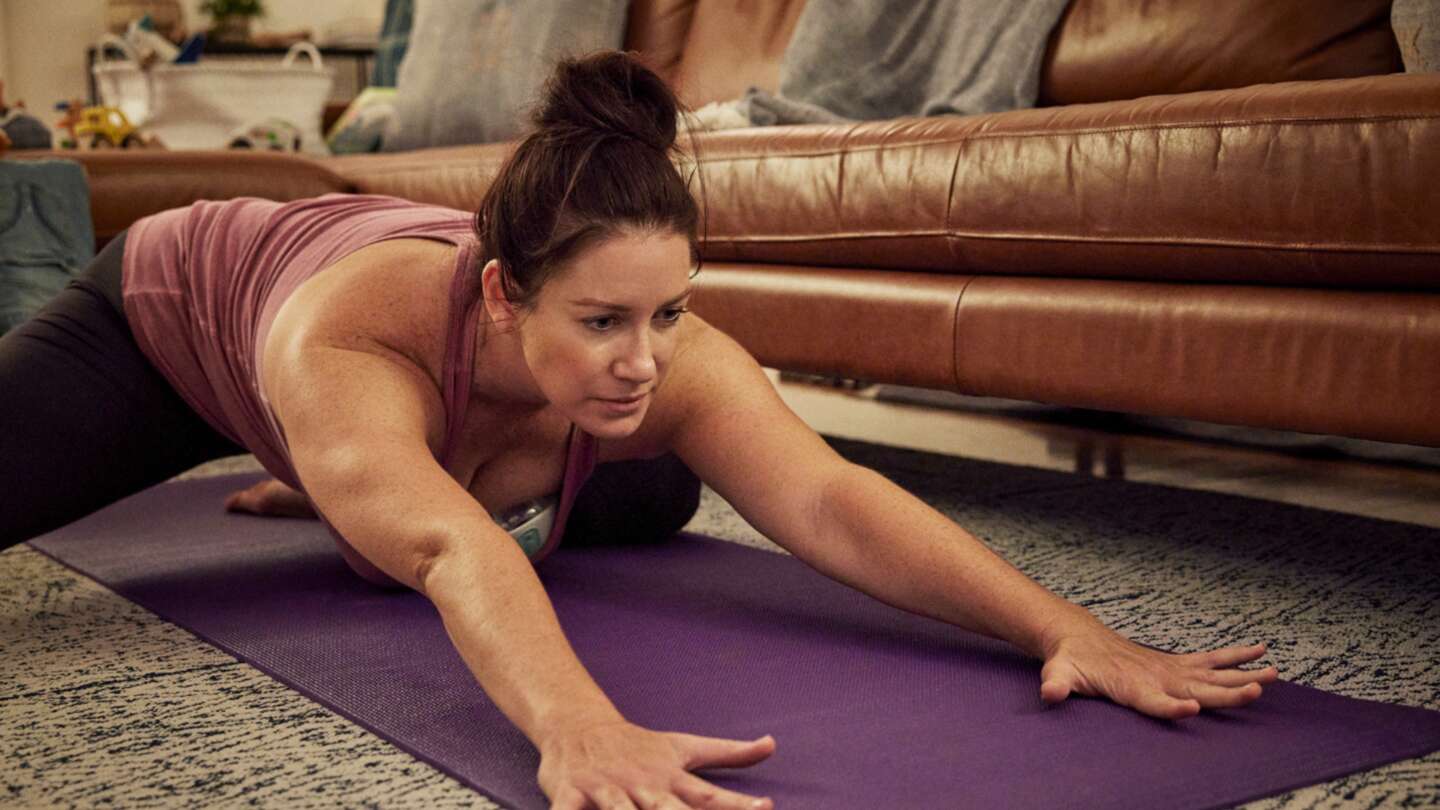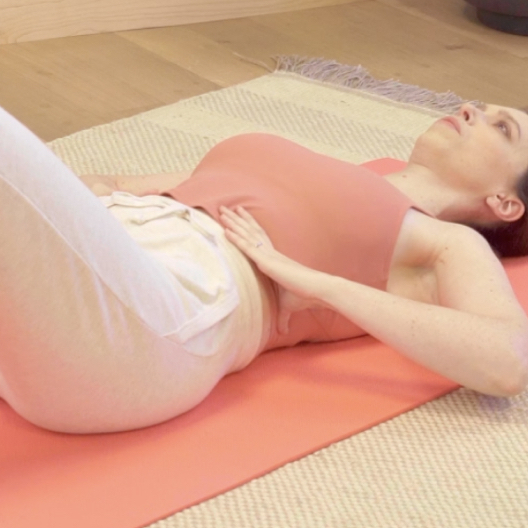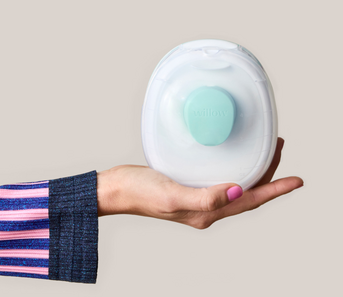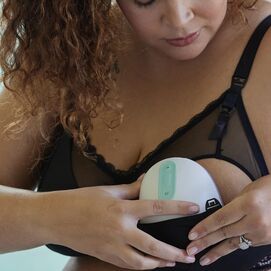The list of things you shouldn’t do in the first six postpartum weeks is fairly long— you can’t have sex, you can’t wear tampons, and you can’t vigorously exercise. If you’ve delivered via C-section, you also can’t lift anything heavy. If we’re being honest, you probably aren’t up for any real physical exertion, anyway, given your aches and pains and sleep deprivation.
After having a baby, getting around might be difficult or downright painful, depending on the circumstances of your pregnancy and delivery. But as you heal, that discomfort will pass—and movement is part of your healing. If you were physically active during your pregnancy and had a normal vaginal delivery, you can resume activity within the first few days after delivery, slowly working back to your pre-pregnancy state.
Start with Mindful Movement
In the early part of recovery, your body might be achy, and you might not feel like moving much. A good way to start is by using a foam roller, gently stretching, or engaging your core through controlled breathing.
“These mindful movements feel really good and help facilitate your body’s natural healing,” says Rachel Welch, a certified health coach, yoga instructor, and founder of the postnatal fitness method Revolution Motherhood.
Welch likes to remind her new-mom clients that they just participated in an incredibly athletic event: giving birth.
“If you did an Iron Man, you wouldn’t just go to bed after,” Welch says. “You’d help your body process what it had just accomplished. Open your muscles, help your circulatory system, and get lots of sleep, good nutrition, and rest.”
Try Out Postpartum Yoga
You may have done some yoga during your pregnancy—it’s very popular. Depending on the advice of your physician, you may be ready for light, restorative postnatal yoga days, rather than weeks, after delivery.
Postnatal yoga is the same low-intensity and slow-moving practice you might be used to from your prenatal yoga days. It can help increase your energy and sense of calm. It can also help you relax and lower your blood pressure, explains Brooke Taylor, a physical-fitness trainer based in New York City.
Yoga may help with your mental recovery as much as your physical recovery. Research shows that postnatal yoga can help alleviate symptoms of postpartum depression1.
You can certainly try to attend an in-person yoga class, but there are plenty of free online classes you can take from the comfort of your home.
Incorporate Walking After Birth
One thing you should add to your routine, if possible, is walking. It’s low-impact, simple, and aids your digestive system, which often undergoes massive changes after delivery, Welch notes.
“Walking also moves the pelvis and engages most of the major muscles of the body, releases tension, improves circulation, and begins to increase your cardiovascular capacity,” Welch says. In other words, walking can get your heart rate up just enough to benefit you, but remain within a low-impact and rehabilitative range for your recovering body.
Benefits of Walking After Delivery
Walking is also beneficial for these reasons:
-
It can get you outside (either with or without your baby, in a stroller or baby carrier)
-
It’s self-regulated; you can monitor your pace, time, and frequency
-
It moves the flow of oxygen through your lungs
-
When outside, it exposes you to Vitamin D, a nutrient in which more than 40 percent of Americans are deficient
- style="font-size: 18px;margin-bottom: 10px;">It helps increase your serotonin, a natural chemical that can help you feel good and sleep well
In some cultures, it is traditional and expected to stay inside and rest with your baby for at least the first postpartum month. While this tradition, known as “sitting the month” in Chinese medicine, is focused on healing and providing for the baby, remaining inside all day with a newborn can feel isolating. It's important for moms to find ways to integrate their new identity with their interactions with the outside world, Welch says.
See Also: Postpartum Self-Care Matters
How to return to movement
Easing your way back into any movement is key, and it’s important to listen to your body. How are you feeling while walking? If your body is tight and hurting from delivery, Welch warns that walking might not be the best movement option quite yet.
“I advise gently walking with your baby for a couple of blocks, in small, slow steps to protect your pubic symphysis, which remains pretty soft for the first couple weeks, post-vaginal birth,” Welch says.
If you’re in pain at any point, or feel fatigued, take things down a notch or two. Doing too much, too quickly, can cause adverse effects, such as pain or fatigue, and may even prolong your recovery. (If you have a diastasis recti, Taylor recommends working with a pelvic-floor physical therapist or a fitness professional who specializes in postpartum recovery to assess and assist you with your healing.)
Taylor recommends investing in a heart rate monitor so you can see how your body responds to exercise.
“With the necessary time that a woman needs to take off to heal, the heart rate can get de-conditioned, which is why you may go for a walk, and your heart rate will be at 70 [percent to] 80 percent of your max,” she says. “By monitoring your heart rate, you can assure that you are training safely, efficiently, and effectively.”
According to the American Heart Association, the target heart rate during moderate-intensity activities is 50 percent to 70 percent of maximum heart rate; during vigorous activity, it’s 70 percent to 85 percent of maximum heart rate3. An average maximum heart rate for a 30-year-old is 190 beats per minute and for a 40-year-old 180 beats per minute.
“Don’t pressure yourself to bounce back right away,” Taylor says. “Instead, focus on the things you can control—resting, a healthy and balanced diet, and moving as you can.”
Step by Step Guide - Returning to Movement After Birth
Brooke Taylor - Owner of Taylored Fitness
As you re-engage with your physical activities, keeping a few anatomical things in mind, such as alignment and muscle engagement, can really help your physical recovery.
Recruit Your Muscles: Try Pelvic Floor Exercises
Your transversus abdominis (TVA) and pelvic-floor muscles have been stretched out significantly during pregnancy, labor, and delivery. Carrying a baby for nine months creates weight displacement, muscle imbalances, and instability in your body, Taylor says. Strengthening your muscles while focusing on balance will bring a connection and awareness back to your core.
Related Reading: Pelvic Floor Exercises
Notice the Angle of Your Pelvis
In those first six postpartum weeks, your body is still moving as if you were pregnant, so Welch recommends focusing on drawing your abdominal muscles up in the front and engaging your glutes.
Think About the Angle of Your Feet
Your feet might not seem important, but think of them as extensions of what’s happening in your core and pelvis. “Imagine your legs begin in your rib cage, and you are supporting the movement of walking from your lungs,” Taylor says. Keep your feet in line with your hips. “Try to articulate your feet while walking (heel-toe and back again),” she says. Walking this way more efficiently engages your power from your core to your feet, and back again.
Give Yourself Grace
Remember that every mom’s journey to resuming movement postpartum is different—and that’s OK. No two women experience pregnancy, labor, and delivery in exactly the same way. It takes time and space to heal, so be sure to give yourself just that.
Transitioning to Parenthood is Hard, But Willow is Here to Help
Being a new mama is an exciting yet exhausting time. It is overwhelming to adjust to a new lifestyle while navigating the changes to your physical body! Check out the Willow blog for expert advice on how to make the transition easier. You've got this!
Pelvic Floor Physical Therapy
Pelvic Floor Physical Therapy
Find virtual or in-person pelvic floor physical therapy with Origin to restore your strength and resume activities like exercise and sex.














